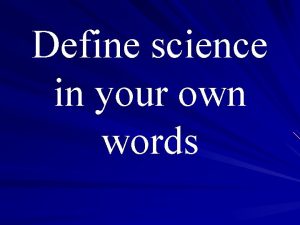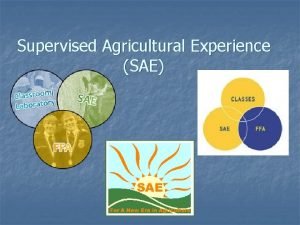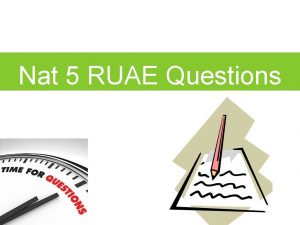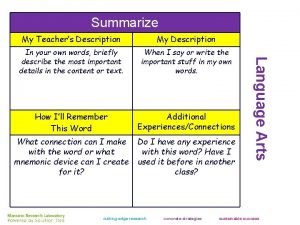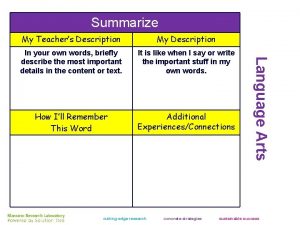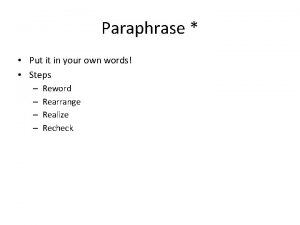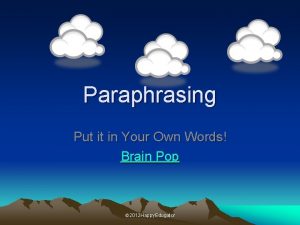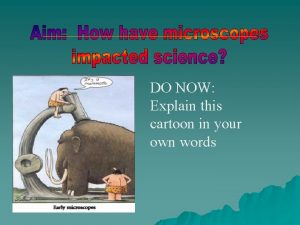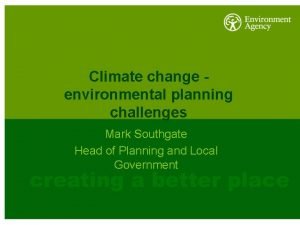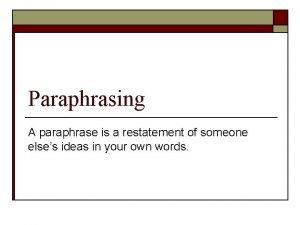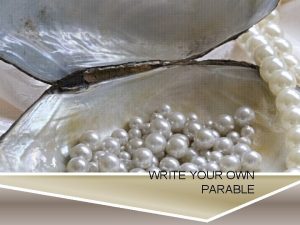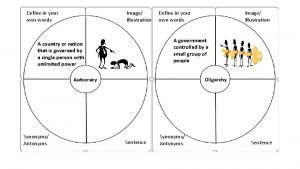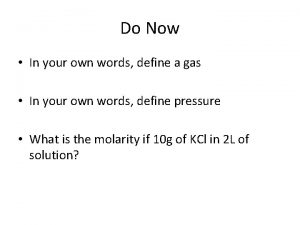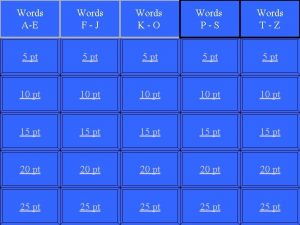Do Now In your own words define CLIMATE






































- Slides: 38

Do Now: In your own words, define CLIMATE.

Global Climate Factors Aim: What natural factors influence our climate?

Climate is…. . the average, general weather conditions over a large area, over a period of time.

1) Latitude – position on Earth

1) Latitude – position on Earth High latitudes = Polar regions Cooler due to low angle of sun – spread out Drier because cooler air (does not hold as much water) and sinking air Low latitudes = equator/tropics Hotter due to direct rays of sun – intense heat Humid due to rising air, which creates clouds

How does latitude affect climate? Temperature As latitude increases ____, the average annual temperature decreases _____. 0° Latitude 90°

2) Planetary Wind Belts Caused by unequal heating of earth, creating global circulation. curve due to the rotation of the Earth = Coriolis Effect ESRT p. 14

Winds and storms track from west to east Prevailing Southwesterlies cause: low pressure system to move towards the NE

3) Mountains as barriers – orographic effect Windward Leeward

Sierra Negra, Galápagos

Windward Side

Leeward Side

Wind coming from right (east) side Leeward Side Windward Side

How does the Orographic Effect affect climate? cool, moist Windward Side: ______ warm, dry Leeward Side: _______

The Lake Effect Snow is a result of a cold air mass moving over a comparatively warm body of water. Westerly winds ls Lake Ontario s nd a , Air e ris o co Tug Hill Plataeu The warm “lake” water evaporates and rises, providing moisture to the air mass. When the cold air mass moves over a higher elevation, such as New York’s Tug Hill Plateau, the clouds precipitate, typically in the form


4) Elevation Higher elevations are cooler.

Page 14 of the ESRTs We live in the troposphere. Temperature decreases with elevation.

How does elevation affect climate? Temperature increases the average As elevation _____, annual temperature _____. decreases Elevation

5) Ocean Currents ESRT p. 4 East coasts of continents: warm ocean currents From equator toward poles West coasts of continents: cold ocean currents From poles toward equator

How do ocean currents affect climate? Warm Currents: warmer climate Cold Currents: cooler climate

Use Page 4 Reference table: 1. Name the ocean current affecting Long Island. 2. Is it a warm or cool current? 3. What current does it turn into as it continues north? 4. How does that affect temperature of Europe?

Use Page 4 Reference table: 1. Name the ocean current affecting Long Island. Gulf Stream Current 2. Is it a warm or cool current? 3. What current does it turn into as it continues north? 4. How does that affect temperature of Europe?

Use Page 4 Reference table: 1. Name the ocean current affecting Long Island. Gulf Stream Current 2. Is it a warm or cool current? Warm 3. What current does it turn into as it continues north? 4. How does that affect temperature of Europe?

Use Page 4 Reference table: 1. Name the ocean current affecting Long Island. Gulf Stream Current 2. Is it a warm or cool current? Warm 3. What current does it turn into as it continues north? North Atlantic Current 4. How does that affect temperature of Europe?

Use Page 4 Reference table: 1. Name the ocean current affecting Long Island. Gulf Stream Current 2. Is it a warm or cool current? Warm 3. What current does it turn into as it continues north? North Atlantic Current 4. How does that affect temperature of Europe? Helps increase Europe’s temperature

6) Closeness to a large body of water

Coastal = water keeps temperatures moderate. Not extremely hot or cold!

Inland = not near water - allows wide range of temperatures

Which city is…… Closer to the coast? B : How can you tell ? It has a smaller temperature range A B

How does closeness to a large body of water affect climate? Water moderates _____ the temperature. Cooler summers. _______ Warmerwinters. _______ Cities A & B are located at the same latitude. City B is closer to a large body of water. Its temperature line is flatter (moderated). *Closer to a large body of water: Increase in precipitation



El Nino El Niño – unusually warm surface current in the Pacific that influences worldwide weather patterns (weak trade winds) La Niña – unusually cold surface current (strong trade winds) excellent el Nino videos




 In your notebook define the following terms
In your notebook define the following terms Define acceleration
Define acceleration Define manifest destiny in your own words.
Define manifest destiny in your own words. Meaning of the word photography
Meaning of the word photography Define loyalty in your own words
Define loyalty in your own words Science in my own words
Science in my own words Analytical sae examples
Analytical sae examples Making new words your own
Making new words your own How to answer in your own words questions
How to answer in your own words questions Describe them briefly
Describe them briefly Description in your own words
Description in your own words Who was the first person to arrive at juliet's tomb
Who was the first person to arrive at juliet's tomb How to put it in your own words
How to put it in your own words Ruae national 5
Ruae national 5 Explain the fccla creed in your own words
Explain the fccla creed in your own words Creed definition fccla
Creed definition fccla Using your own words
Using your own words Oligarchy explanation
Oligarchy explanation Put in your own words
Put in your own words Summarise in your own words
Summarise in your own words Making new words your own lesson 2
Making new words your own lesson 2 Meaning of intramurals
Meaning of intramurals Ffa 3rd paragraph
Ffa 3rd paragraph In your own words questions
In your own words questions What is retelling
What is retelling Presenting someone else's words or ideas as your own is
Presenting someone else's words or ideas as your own is Compound light microscope cartoon
Compound light microscope cartoon Conclusion of entrepreneurship
Conclusion of entrepreneurship Your conscious awareness of your own name and self identity
Your conscious awareness of your own name and self identity Climate change 2014 mitigation of climate change
Climate change 2014 mitigation of climate change Act now climate change
Act now climate change Now i see it now you don't
Now i see it now you don't Define climate
Define climate Give us your hungry your tired your poor
Give us your hungry your tired your poor Mother teresa in my own words
Mother teresa in my own words Restating or paraphrasing
Restating or paraphrasing Jesus in his own words
Jesus in his own words Create your own top level domain
Create your own top level domain Create your own parable
Create your own parable





